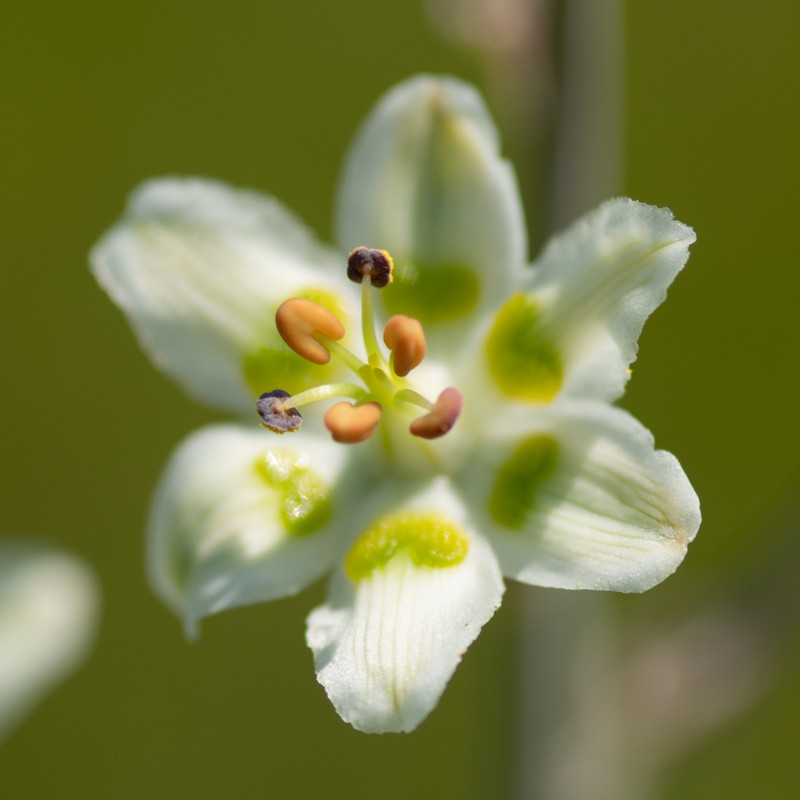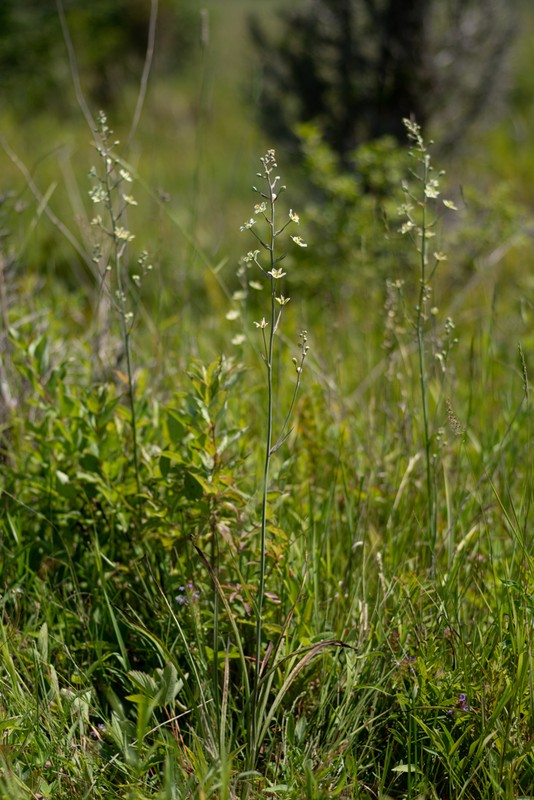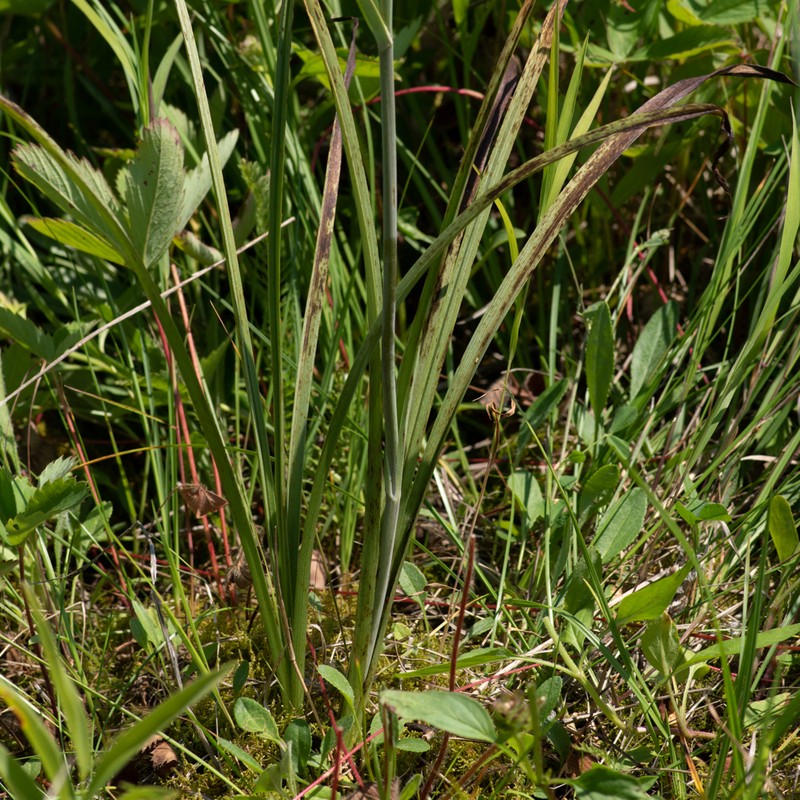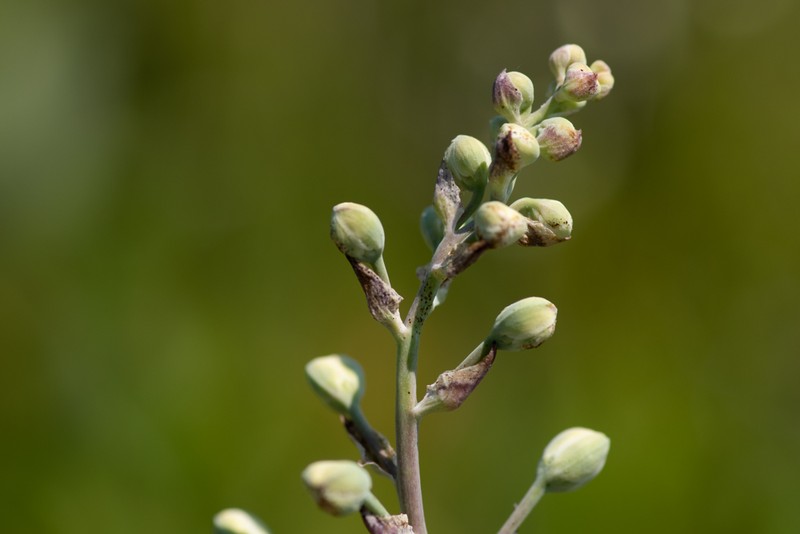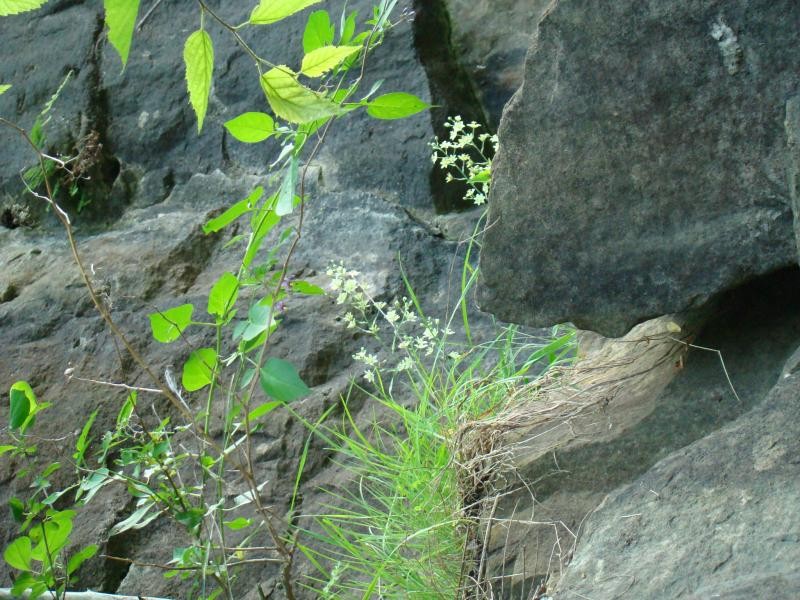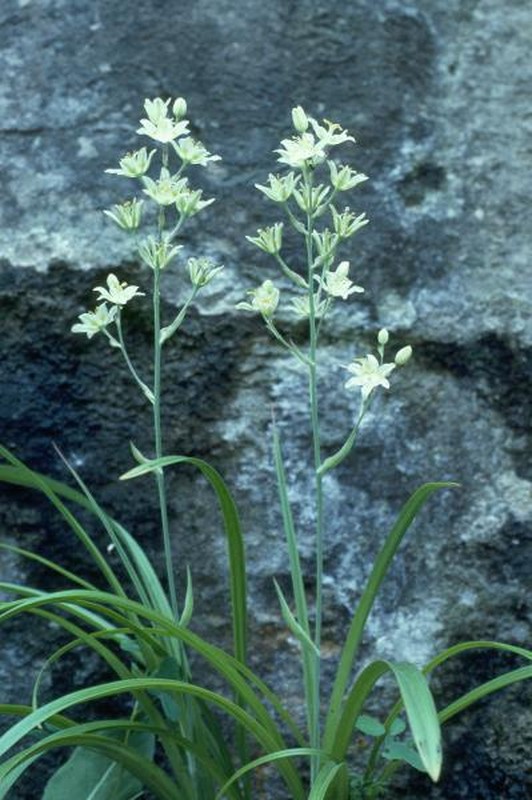White Death Camas
Anticlea elegans var. glauca (Nutt.) Zomlefer & Judd
- Class
- Monocotyledoneae (Monocots)
- Family
- Melanthiaceae
- State Protection
- Threatened
Listed as Threatened by New York State: likely to become Endangered in the foreseeable future. For animals, taking, importation, transportation, or possession is prohibited, except under license or permit. For plants, removal or damage without the consent of the landowner is prohibited.
- Federal Protection
- Not Listed
- State Conservation Status Rank
- S2
Imperiled in New York - Very vulnerable to disappearing from New York due to rarity or other factors; typically 6 to 20 populations or locations in New York, very few individuals, very restricted range, few remaining acres (or miles of stream), and/or steep declines.
- Global Conservation Status Rank
- G5T4T5
Apparently or Demonstrably Secure globally - The subspecies/variety is uncommon to common in the world, but not rare; usually widespread, but may be rare in some parts of its range; possibly some cause for long-term concern due to declines or other factors. More information is needed to assign either T4 or T5. (The species as a whole is common globally.)
Summary
Did you know?
The mountain death camus is very poisonous to humans and livestock and is said to be more potent than strychnine. All parts are poisonous and livestock can be affected in the early spring when the fresh green leaves start to grow.
State Ranking Justification
There are nine existing populations and almost all of them are large. One small population has not been seen since 1992. There are five historical populations. One site near Syracuse was extirpated by development.
Short-term Trends
Short-term trends are stable.
Long-term Trends
Long-term trends are stable to increasing since most of the historical populations still exist and new populations have been found in Jefferson County.
Conservation and Management
Threats
Invasive species are increasing at these sites, especially black swallow-wort, bush honeysuckle, and garlic mustard. ATV use in alvar areas can threaten populations. Some plants that are visible in public parks may be threatened by collection.
Conservation Strategies and Management Practices
Invasive species populations should be suppressed near populations of mountain death camas. ATV traffic should be kept away from populations.
Research Needs
There are no research needs at this time.
Habitat
Habitat
In New York, Mountain Death Camas has been found growing on calcareous soils at both wet (rich graminoid and marl fens, dripping limestone cliffs) and dry (alvar grasslands and calcareous pavement barrens) sites (New York Natural Heritage Program 2010). Beaches, bogs and other wet, often calcareous places (Gleason and Cronquist 1991). Dunes and sandy or rocky shores of the Great Lakes, also inland on calcareous soils and banks, in bogs and low ground (Voss 1972).
Associated Ecological Communities
- Alvar pavement grassland
(guide)
This community consists of exposed, flat limestone or dolostone pavement with grassy or mossy patches interspersed throughout. Some examples may be solely grassland with no pavement.
- Calcareous cliff community
(guide)
A community that occurs on vertical exposures of resistant, calcareous bedrock (such as limestone or dolomite) or consolidated material; these cliffs often include ledges and small areas of talus.
- Calcareous red cedar barrens*
(guide)
A small-patch calcareous rocky summit community occurring on dry, south-facing to southwest-facing slopes and low summits. These sites are characterized by stunted, sparse woodlands with small grassland openings.
- Calcareous shoreline outcrop*
(guide)
A community that occurs along the shores of lakes and streams on outcrops of calcareous rocks such as limestone and dolomite. The vegetation is sparse; most plants are rooted in rock crevices.
- Cobble shore wet meadow
(guide)
A community that occurs on the cobble shores of lakes and streams where the substrate is moist from seepage or intermittent flooding. These communities are likely to be scoured by floods or winter ice floes, but there is apparently no significant accumulation of pack ice.
- Marl fen
(guide)
A wetland that occurs on a bed of marl. Marl is a whitish substance that is deposited from water that has a lot of calcium dissolved in it. The whitish substance is calcium carbonate, people used to harvest marl to lime agricultural fields. The marl substrate is always saturated, may be flooded, and has a very high pH, generally greater than 7.5. The main source of water is always groundwater. The plants are often sparse and stunted. Marl fens may occur as small patches within a rich graminoid fen.
- Rich graminoid fen
(guide)
A wetland of mostly grasses usually fed by water from highly calcareous springs or seepage. These waters have high concentrations of minerals and high pH values, generally from 6.0 to 7.8. Plant remains do not decompose rapidly and these grasses usually grow on older, undecomposed plant parts.
* probable association but not confirmed.
Associated Species
- Ageratina altissima var. altissima (common white snakeroot)
- Aquilegia canadensis (wild columbine, red columbine)
- Argentina anserina
- Bromus ciliatus (fringed brome)
- Campanula rotundifolia (hare-bell)
- Carex aurea (golden-fruited sedge)
- Carex crawei (Crawe's sedge)
- Castilleja coccinea (Indian paint-brush, scarlet paint-brush)
- Cystopteris bulbifera (bulblet fern)
- Deschampsia cespitosa (tufted hair grass)
- Eleocharis compressa
- Eleocharis rostellata (walking spike-rush)
- Equisetum hyemale
- Equisetum variegatum
- Fraxinus americana (white ash)
- Juniperus horizontalis (creeping juniper)
- Lonicera tatarica (Tartarian honeysuckle)
- Lythrum salicaria (purple loosestrife)
- Oligoneuron ohioense
- Packera paupercula (balsam groundsel)
- Parnassia glauca (common grass-of-Parnassus)
- Pinguicula vulgaris (butterwort)
- Primula mistassinica (Lake Mistassini primrose, bird's-eye primrose)
- Saxifraga aizoides (yellow mountain saxifrage)
- Selaginella apoda (meadow spikemoss)
- Solanum dulcamara (bitter-sweet nightshade)
- Solidago juncea (early goldenrod)
- Sphagnum
- Sporobolus heterolepis (prairie dropseed)
- Thuja occidentalis (northern white cedar, arbor vitae)
- Triantha glutinosa (sticky false asphodel)
- Trichophorum cespitosum
- Trichostema brachiatum (false pennyroyal)
- Triglochin
Range
New York State Distribution
This plant is restricted to the calcareous region along the St.Lawrence River south to eastern Lake Ontario and calcareous outcrops along the Genesee and Niagara Rivers, with some historical collections known from along the Onondaga Limestone Escarpment.
Global Distribution
Anticlea elegans ssp. glaucus reaches its eastern limit at Lake Champlain, ranges west to North Dakota,and is found in scattered locations along the Appalachians south to Tennesse and west to Missouri. All of our New York plants are subspecies glaucus. The other subspecies, elegans, is generally north and west of ssp. glaucus, though the ranges are somewhat overlapping.
Identification Comments
General Description
Anticlea elegans var. glaucus grows from bulbs with erect stems reaching up to 60 cm tall. The leaves are glaucous, especially when young, and crowded towards the base. The inflorescence is an elongate panicle 5 to 45 cm long. Its bracts are herbaceous, taper to a firm narrow pointed tip and are strongly infused with green, brown, bronze or purple color. The flowers have creamy white to greenish yellow tepals 7 to 15 mm long, and a distinctive, strong odor. A single conspicuous, heart-shaped gland is present below the middle of each tepal. The fruits are narrowly oval-shaped cones 1 to 1.4 cm long and 5 to 8 mm in diameter, barely exceeding the perianth (Fernald 1950).
Identifying Characteristics
Anticlea elegans var. glaucus grows from bulbs with erect stems reaching up to 60 cm tall. The outer bulb coat is fibrous. The leaves are glaucous especially when young, and crowded towards the base. The inflorescence is an elongate, narrow oval tapering at both ends (lanceolate) to an egg-shaped (ovoid) open panicle 5 to 45 cm long. Its bracts are herbaceous, taper to a firm narrow pointed tip and are strongly infused with green, brown, bronze or purple color. The base of the outer portion of the flower (perianth) is connected with the ovary, the sepals and petals are 7 to 15 mm long, and creamy white to greenish yellow. A single conspicuous heart-shaped gland is present below the middle of each petal. The flowers have a strong, distinctive odor. The fruit capsules are a narrowly oval-shaped cone 1 to 1.4 cm long and 5 to 8 mm in diameter, and barely exceeding the perianth (Fernald 1950).
Best Life Stage for Proper Identification
Flowering or fruiting individuals are best for identification.
Similar Species
This plant was formerly in the genus Zigadenus. The remaining Zigadenus species in New York (Z. leimanthoides) Z. leimanthoides is only found along the coastal plain of Long Island, outside the known range of Anticlea elegans ssp. glaucus. The two are also easily distinguished morphologically. The tepals of Zigadenus leimanthoides are smaller (3-6 mm) with only a single unlobed gland at the base. Vegetatively, A. elegans var. glaucus could look like a number of members within the Liliaceae (especially Veratrum and Amianthium species), so it is important to identify the plant with fruit or flowers.
Best Time to See
Anticlea elegans ssp. glaucus typically flowers from late June through August with fruits persisting until the first frost.
- Flowering
- Fruiting
The time of year you would expect to find White Death Camas flowering and fruiting in New York.
White Death Camas Images
Taxonomy
White Death Camas
Anticlea elegans var. glauca (Nutt.) Zomlefer & Judd
- Kingdom Plantae
- Phylum Anthophyta
- Class Monocotyledoneae
(Monocots)
- Order Liliales
- Family Melanthiaceae
- Order Liliales
- Class Monocotyledoneae
(Monocots)
- Phylum Anthophyta
Additional Common Names
- Alkali-grass
- Mountain Death Camas
- White Camas
- White Camass
Synonyms
- Anticlea elegans ssp. glaucus (Nutt.) A. Haines
- Anticlea glauca (Nutt.) Kunth
- Zigadenus elegans ssp. glaucus (Nutt.) Hulten
- Zigadenus elegans var. glaucus (Nutt.) Cronq.
- Zigadenus glaucus Nutt.
Comments on the Classification
Based on molecular and morphological studies the genus Zigadenus has been segregated into a few distinct genera including Anticlea.
Additional Resources
Best Identification Reference
Fernald, M. L. 1950. Gray's manual of botany. 8th edition. Corrected printing (1970). D. Van Nostrand Company, New York. 1632 pp.
Other References
Flora of North America Editorial Committee. 2002. Flora of North America, North of Mexico. Volume 26. Magnoliophyta: Liliidae: Liliales and Orchidales. Oxford University Press, New York. 723 pp.
Gleason, Henry A. and A. Cronquist. 1991. Manual of Vascular Plants of Northeastern United States and Adjacent Canada. The New York Botanical Garden, Bronx, New York. 910 pp.
Holmgren, Noel. 1998. The Illustrated Companion to Gleason and Cronquist's Manual. Illustrations of the Vascular Plants of Northeastern United States and Adjacent Canada. The New York Botanical Garden, Bronx, New York.
Mitchell, Richard S. and Gordon C. Tucker. 1997. Revised Checklist of New York State Plants. Contributions to a Flora of New York State. Checklist IV. Bulletin No. 490. New York State Museum. Albany, NY. 400 pp.
New York Natural Heritage Program. 2024. New York Natural Heritage Program Databases. Albany, NY.
Voss, E.G. 1972. Michigan Flora, Part I. Gymnosperms and Monocots. Cranbrook Institute of Science Bulletin 55 and the University of Michigan Herbarium. Ann Arbor. 488 pp.
Weldy, T. and D. Werier. 2010. New York flora atlas. [S.M. Landry, K.N. Campbell, and L.D. Mabe (original application development), Florida Center for Community Design and Research http://www.fccdr.usf.edu/. University of South Florida http://www.usf.edu/]. New York Flora Association http://newyork.plantatlas.usf.edu/, Albany, New York
Zomlefer, W.B., N.H. Williams, W.M. Whitten, and W.S. Judd. 2001. Generic circumscription and relationships in the tribe Melanthieae (Liliales, Melanthiaceae), with emphasis on Zigadenus: evidence from ITS and trnL-F sequence data. Amer. J. Bot. 88: 1657-1669.
Links
About This Guide
This guide was authored by: Stephen M. Young, Elizabeth Spencer, Richard M. Ring.
Information for this guide was last updated on: October 25, 2022
Please cite this page as:
New York Natural Heritage Program. 2024.
Online Conservation Guide for
Anticlea elegans var. glauca.
Available from: https://guides.nynhp.org/mountain-death-camas/.
Accessed July 26, 2024.

